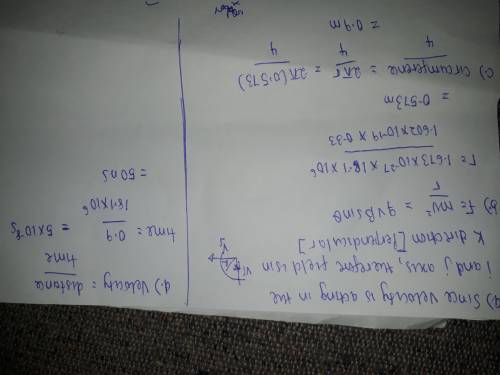
Physics, 10.03.2020 02:59 silasjob09
A proton having an initial velocity of 18.1 Mm/s enters a uniform magnetic field of magnitude 0.330 T with a direction perpendicular to the proton's velocity. It leaves the field-filled region with velocity -18.1 Mm/s.
(a) Determine the direction of the magnetic field.
(b) Determine the radius of curvature of the proton's path while in the field.
m
(c) Determine the distance the proton traveled in the field.
m
(d) Determine the time interval for which the proton is in the field.
ns

Answers: 3
Another question on Physics

Physics, 22.06.2019 07:10
1. how much energy is needed to raise the temperature of 40.0 g of argon from 25c to 40c? the specific heat capacity of argon is 0.520 j/(g·k) 2a. 23.0 ml of 0.100 m hcl (standard) are added from a buret to neutralize 50.0 ml of an unknown basic solution. 2b. if the oh- produced in the previous reaction came from ca(oh)2, then what is the molarity of the ca(oh)2? 3.calculate the new freezing-point of a solution when 60.5 grams of cacl2 solute is dissolved in 0.612 kg of water. 4. what is the maximum number of moles of alcl3 that can be produced from 5.0 mol al and 6.0 mol cl2? 5. a sample of oxygen gas has a volume of 150 ml when its pressure is 0.923 atm. if the pressure is increased to 0.987 atm and the temperature remains constant, what will the new volume be? 6. nitrogen gas in a closed container at a temperature of 100.0 oc and 3.0 atm is heated to 300 oc. what is the pressure of the gas at the higher temperature?
Answers: 3

Physics, 22.06.2019 07:40
Which best describes how fluids change as they travel through different portions of the convection currents? they change to solids at the outer portion of the convection currents. they change to solids at the inner portion of the convection currents. they become more dense at the outer portion of the convection currents. they become more dense at the inner portion of the convection currents
Answers: 2

Physics, 22.06.2019 14:20
Antireflective coatings on solar cells are often made by applying a thin film of silicon nitride (sinx), which has an index of refractive of 1.2, on the top of the silicon solar cell, which has a refractive index of about 3.5. however, the sun emits radiation of various wavelengths which the solar cell absorbs, and the antireflective coating can only absolutely minimize the reflection of one of these wavelengths. the coating thickness is chosen to reduce the reflection of green/yellow light (e = 2.2 ev), which is the most intense color in the solar spectrum (shown below). which of the following coatings would minimize reflection of green/yellow light? the answer is 820 nm how? what is the angular width of the central maximum of an electron traveling at 2 x 108 m/s going through a single slit of width 1 mm.
Answers: 1

Physics, 22.06.2019 21:30
Atoaster oven has a resistive heating element. the average rate at which it dissipates energy as thermal energy is 1.00 \(\rm kw\). in the united states, emf amplitude in household circuits is \(\mathcal e_{\max}\) = 170 \({\rm \; v}\) and the \(\rm ac\) oscillation rate is 60 \(\rm hz\). part a what is the root-mean-square current through the heating element?
Answers: 2
You know the right answer?
A proton having an initial velocity of 18.1 Mm/s enters a uniform magnetic field of magnitude 0.330...
Questions

Mathematics, 22.10.2019 22:00










Mathematics, 22.10.2019 22:00

History, 22.10.2019 22:00




Physics, 22.10.2019 22:00


Geography, 22.10.2019 22:00





